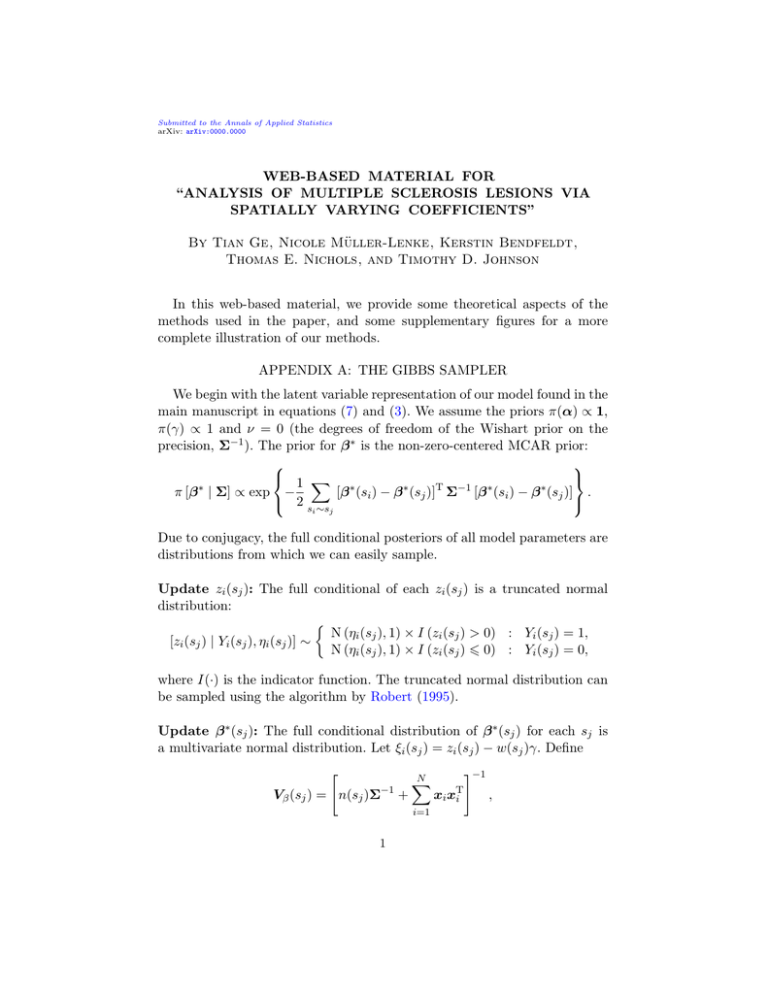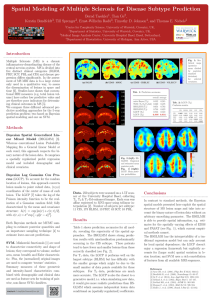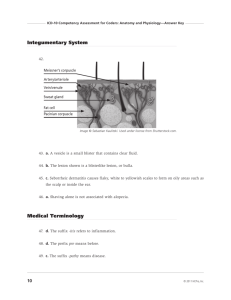WEB-BASED MATERIAL FOR “ANALYSIS OF MULTIPLE SCLEROSIS LESIONS VIA SPATIALLY VARYING COEFFICIENTS”
advertisement

Submitted to the Annals of Applied Statistics
arXiv: arXiv:0000.0000
WEB-BASED MATERIAL FOR
“ANALYSIS OF MULTIPLE SCLEROSIS LESIONS VIA
SPATIALLY VARYING COEFFICIENTS”
By Tian Ge, Nicole Müller-Lenke, Kerstin Bendfeldt,
Thomas E. Nichols, and Timothy D. Johnson
In this web-based material, we provide some theoretical aspects of the
methods used in the paper, and some supplementary figures for a more
complete illustration of our methods.
APPENDIX A: THE GIBBS SAMPLER
We begin with the latent variable representation of our model found in the
main manuscript in equations (7) and (3). We assume the priors π(α) ∝ 1,
π(γ) ∝ 1 and ν = 0 (the degrees of freedom of the Wishart prior on the
precision, Σ−1 ). The prior for β ∗ is the non-zero-centered MCAR prior:
1 X
π [β ∗ | Σ] ∝ exp −
[β ∗ (si ) − β ∗ (sj )]T Σ−1 [β ∗ (si ) − β ∗ (sj )] .
2
si ∼sj
Due to conjugacy, the full conditional posteriors of all model parameters are
distributions from which we can easily sample.
Update zi (sj ): The full conditional of each zi (sj ) is a truncated normal
distribution:
N (ηi (sj ), 1) × I (zi (sj ) > 0) : Yi (sj ) = 1,
[zi (sj ) | Yi (sj ), ηi (sj )] ∼
N (ηi (sj ), 1) × I (zi (sj ) 6 0) : Yi (sj ) = 0,
where I(·) is the indicator function. The truncated normal distribution can
be sampled using the algorithm by Robert (1995).
Update β ∗ (sj ): The full conditional distribution of β ∗ (sj ) for each sj is
a multivariate normal distribution. Let ξi (sj ) = zi (sj ) − w(sj )γ. Define
"
Vβ (sj ) = n(sj )Σ−1 +
N
X
i=1
1
#−1
xi xT
i
,
2
T. GE ET AL.
and
µβ (sj ) = Vβ (sj ) Σ−1
X
β ∗ (sr ) +
sr ∈∂sj
N
X
ξi (sj )xi .
i=1
Then
[β ∗ (sj ) | β ∗ (sr ), sr ∈ ∂sj , Σ, ξi (sj )] ∼ MVN (µβ , Vβ ) .
Update γ: The full conditional of γ is also multivariate normal. Let ζi (sj ) =
∗
zi (sj ) − xT
i β (sj ). Define
Vγ = N
M
X
−1
w2 (sj )
,
j=1
and
N X
M
X
µγ = V γ
w(sj )ζi (sj ) .
i=1 j=1
Then
[γ | ζi (sj )] ∼ MVN (µγ , Vγ ) .
Update Σ−1 : The full conditional of Σ−1 is a Wishart distribution. Let
X
[β ∗ (si ) − β ∗ (sj )] [β ∗ (si ) − β ∗ (sj )]T .
S = I +
si ∼sj
Then
−1
Σ | β ∗ ∼ W M − 1 + ν, S −1 .
APPENDIX B: LEAVE-ONE-OUT CROSS-VALIDATION (LOOCV)
To assess the predictive capabilities of MRI imaging along with the five
covariates age, gender, disease duration, EDSS and PASAT under our model,
we use a cross-validation approach. Leaving one subject out at a time, the
posterior is estimated from the remaining subjects and a prediction is made
3
WEB-BASED MATERIAL
on the subtype of the subject left out. The procedure is repeated for each
subject and the classification rate based on all the subjects is computed.
To avoid sampling from the posterior distribution for each leave-one-out
situation, an importance sampling approach originally proposed by Gelfand,
Dey and Chang (1992) is used to reduce the computation of LOOCV.
Let yi = [yi (s1 ), · · · , yi (sM )]T denote the binary data of all voxels from
subject i. DN = {yi , gi }N
i=1 consists of the data from all the N subjects
where gi is a sample realization of the subtype indicator Gi ∈ {1, · · · , G}.
G is the number of subtypes. Let D−` = {yi , gi }i6=` denote the data with
subject ` left out. The goal is to make inference on the subtype gi given the
binary image, the covariates, and the observed data D−i for each subject
i. Let Θ denote all model parameters. It can be shown that the LOOCV
predictive probabilities of gi for i = 1, · · · , N is given by
Pr(Gi = g | yi , D−i ) = PG
(S1)
qg Qggi
g 0 =1 qg 0 Qg 0 gi
,
where qg = Pr(Gi = g), g = 1, · · · , G is the prior probability for the subtype
g and
Z
Pr(yi | Gi = g, Θ)
Qggi =
π(Θ | DN )dΘ.
Pr(yi | Gi = gi , Θ)
A proof of equation (S1) is given below. The algorithm to estimate the
LOOCV predictive probabilities is as follow:
• Run the Gibbs sampler for K iterations after burn-in to obtain posterior draws Θ(k) ∼ π(Θ | DN ), for k = 1, · · · , K.
• For each subject i and each subtype g, compute
b gg
Q
i
K
1 X Pr yi | Gi = g, Θ(k)
,
=
(k)
K
Pr
y
|
G
=
g
,
Θ
i
i
i
k=1
Q
(k) yi (sj ) ×
where Pr yi | Gi = g, Θ(k) = M
j=1 Pr Yi (sj ) = 1 | Gi = g, Θ
Pr Yi (sj ) = 0 | Gi = g, Θ(k)
1−yi (sj )
.
• The estimate of the predictive probability of Gi is given by
b
c i = g | yi , D−i ) = P qg Qggi
Pr(G
.
G
b
g 0 =1 qg 0 Qg 0 gi
4
T. GE ET AL.
And the estimate of Gi is:
b gg ).
gbi = arg max(qg Q
i
g
The G × G LOOCV confusion matrix C = {cgg0 } is then defined as
PN
c
gg 0
gi )
i=1 Ig (gi )Ig 0 (b
,
PN
i=1 Ig (gi )
=
where Iu (v) is an indicator function. Iu (v) = 1 if u = v and Iu (v) = 0
otherwise. Then the overall and the average correct classification rates are
N
G
1 X
1 X
respectively given by co =
cgg .
Igi (b
gi ) and ca =
N
G
i=1
g=1
Proof of equation (S1). The LOOCV posterior predictive probabilities of gi is:
Pr(Gi = g | yi , D−i )
Z
=
Pr(Gi = g | yi , Θ)π(Θ | yi , D−i )dΘ
Z
π(Θ | yi , D−i )
=
Pr(Gi = g | yi , Θ)
π(Θ | yi , Gi = gi , D−i )dΘ
π(Θ | yi , Gi = gi , D−i )
Z
π(Θ | yi , D−i )
=
Pr(Gi = g | yi , Θ)
π(Θ | DN )dΘ.
π(Θ | yi , Gi = gi , D−i )
Note that
π(Θ | yi , D−i )
π(Θ | yi , Gi = gi , D−i )
=
=
π(Θ, yi , D−i )π(yi , Gi = gi , D−i )
π(yi , D−i )π(Θ, yi , Gi = gi , D−i )
Pr(Gi = gi | yi , D−i )
.
Pr(Gi = gi | yi , Θ)
This implies
Pr(Gi = g | yi , D−i )
Pr(Gi = gi | yi , D−i )
Pr(Gi = g | yi , Θ)
π(Θ | DN )dΘ
Pr(Gi = gi | yi , Θ)
Z
Pr(yi | Gi = g, Θ)qg
=
π(Θ | DN )dΘ
Pr(yi | Gi = gi , Θ)qgi
qg
:=
Qggi .
qg i
Z
=
5
WEB-BASED MATERIAL
Since
PG
g=1 Pr(Gi
= g | yi , D−i ) = 1, if follows that
X qi
1 − Pr(Gi = gi | yi , D−i )
Qggi .
=
Pr(Gi = gi | yi , D−i )
qgi
g6=gi
Therefore
Pr(Gi = g | yi , D−i ) = PG
qg Qggi
g 0 =1
qg0 Qg0 gi
.
APPENDIX C: NAÏVE BAYESIAN CLASSIFIER
A naı̈ve Bayesian classifier is used to predict the subtype of the heldout subject and is compared to the classification results of the Bayesian
spatial model. The naı̈ve Bayesian classifier assumes all features are mutually
independent. For the present study, this assumption implies all voxels are
treated independently. The predictive probability is
Pr(Gi = g | yi , D−i ) ∝ Pr(yi | Gi = g, D−i ) Pr(Gi = g)
= qg
M
Y
Pr (yi (sj ) | Gi = g, D−i ) ,
j=1
where the second equality follows from the independence assumption. At
each voxel sj , assume Pr (Yi (sj ) = 1 | Gi = g) = pg (sj ), and pg (sj ) is assigned Jeffrey’s prior: Beta(0.5, 0.5). Then the posterior distribution of pg (sj )
is also beta distributed. The probability Pr (yi (sj ) | Gi = g, D−i ) is then estimated by the posterior mean of pg (sj ):
P
0.5 + `6=i y` (sj )IG` (g)
c
P
,
Pr (Yi (sj ) = 1 | Gi = g, D−i ) =
1 + `6=i IG` (g)
and
c (Yi (sj ) = 0 | Gi = g, D−i ) = 1 − Pr
c (Yi (sj ) = 1 | Gi = g, D−i ) .
Pr
Finally, the estimate of Gi is given by
M
Y
c (yi (sj ) | Gi = g, D−i ) .
gbi = arg max qg
Pr
g
j=1
6
T. GE ET AL.
APPENDIX D: SUPPLEMENTARY FIGURES
●
10
S
S S
S
C
P
CC
C
C
C C
C
C
CCC
CC
C
C
CC
CCC
CC
CC CC
CCCC C
C
C
CC
C
C C
C
C
0
5
Cube Root of Lesion Load
15
Misclassification
Box Plot
Plot
Misclassification Box
C
C
C
C
S
C
C
C
C
C
CIS
RLRM
PRP
SCP
PRL
MS Subtype
Fig S1. Box plot of lesion load, measured in cube root of the number of lesion voxels.
The letters on the box plot are those misclassified subjects: C – -misclassified as CIS; R
— misclassified as RLRM; P — misclassified as PRP; S — misclassified as SCP; L —
misclassified as PRL. From this figure it is evident that those misclassified as CIS tend to
have relatively small lesion load.
7
WEB-BASED MATERIAL
CIS
RLRM
PRP
SCP
PRL
>35%
18%
1%
Fig S2. Empirical lesion rates for each subtype, CIS, RLRM, PRP, SCP, and PRL, from
left to right. The intensity shown is the proportion of subjects with a lesion at each voxel.
Color scale is set from 1% to 35% (rates below 1% are not shown, rates of 35% or greater
have maximal yellow color). Extent of colored regions is less informative about absolute
rate than a reflection of sample sizes in each group.
8
T. GE ET AL.
CIS
RLRM
PRP
SCP
PRL
>35%
18%
1%
Fig S3. Model estimates of lesions incidence for each subtype, CIS, RLRM, PRP, SCP,
and PRL, from left to right. Intensity at each voxel is the prediction of lesion incidence
using our Bayesian spatial model, which implicitly learns the smoothness of the incidence
maps and regularizes the rates accordingly. Color scale is set from 1% to 35% (rates below
1% are not shown, rates of 35% or greater have maximal yellow color).
9
WEB-BASED MATERIAL
Gender
Age
Disease
Duration
>5
4
3
2
-2
-3
-4
<-5
Fig S4. Standardized (posterior mean divided by posterior standard deviation) spatial maps
for gender, age and disease duration from our Bayesian spatial model. Color scale is set
from 2 to 5 for positive values (values below 2 are not shown, values of 5 or greater have
maximal yellow color), and from -5 to -2 for negative values (values above -2 are not
shown, values of -5 or smaller have the lightest blue color).
10
T. GE ET AL.
>35%
18%
Lesion
Counts
EDSS
PASAT
>5
4
3
1%
2
-2
-3
-4
<-5
Fig S5. The left column is the empirical lesion counts. Color scale is set from 1% to
35%. The middle and right columns are standardized (posterior mean divided by posterior
standard deviation) spatial maps for EDSS and PASAT respectively from our Bayesian
spatial model. Color scale is set from 2 to 5 for positive values (values below 2 are not
shown, values of 5 or greater have maximal yellow color), and from -5 to -2 for negative
values (values above -2 are not shown, values of -5 or smaller have the lightest blue color).
11
WEB-BASED MATERIAL
Gender
Age
Disease
Duration
>5
4
3
2
-2
-3
-4
<-5
Fig S6. Standardized (mean divided by standard deviation) spatial maps for gender, age
and disease duration from the Firth logistic regression. Color scale is set from 2 to 5 for
positive values (values below 2 are not shown, values of 5 or greater have maximal yellow
color), and from -5 to -2 for negative values (values above -2 are not shown, values of -5
or smaller have the lightest blue color).
12
T. GE ET AL.
>35%
18%
Lesion
Counts
EDSS
PASAT
>5
4
3
1%
2
-2
-3
-4
<-5
Fig S7. The left column is the empirical lesion counts. Color scale is set from 1% to
35%. The middle and right columns are standardized (mean divided by standard deviation)
spatial maps for EDSS and PASAT from the Firth logistic regression. Color scale is set
from 2 to 5 for positive values (values below 2 are not shown, values of 5 or greater have
maximal yellow color), and from -5 to -2 for negative values (values above -2 are not
shown, values of -5 or smaller have the lightest blue color).
WEB-BASED MATERIAL
13
REFERENCES
Gelfand, A. E., Dey, D. K. and Chang, H. (1992). Model determination using predictive distributions with implementation via sampling-based methods. Bayesian Statisitcs
4 147–167.
Robert, C. P. (1995). Simulation of truncated normal variables. Statistics and Computing
5 121–125.



